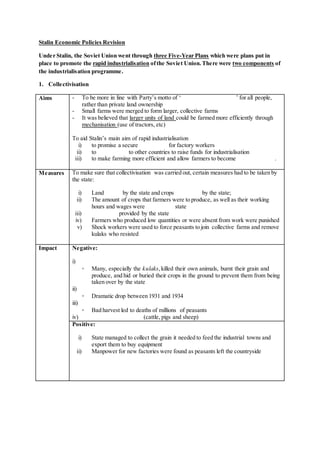
Stalin economic policies revision
- 1. Stalin Economic Policies Revision Under Stalin, the Soviet Union went through three Five-Year Plans which were plans put in place to promote the rapid industrialisation ofthe Soviet Union.There were two components of the industrialisation programme. 1. Collectivisation Aims - To be more in line with Party’s motto of ‘Peace,Land and Bread’ for all people, rather than private land ownership - Small farms were merged to form larger, collective farms - It was believed that larger units of land could be farmed more efficiently through mechanisation (use of tractors, etc) To aid Stalin’s main aim of rapid industrialisation i) to promise a secure food supply for factory workers ii) to export crops to other countries to raise funds for industrialisation iii) to make farming more efficient and allow farmers to become factory workers. Measures To make sure that collectivisation was carried out, certain measures had to be taken by the state: i) Land owned by the state and crops distributed by the state; ii) The amount of crops that farmers were to produce, as well as their working hours and wages were fixed by the state iii) Equipment provided by the state iv) Farmers who produced low quantities or were absent from work were punished v) Shock workers were used to force peasants to join collective farms and remove kulaks who resisted Impact Negative: i) Peasant resistance ◦ Many, especially the kulaks,killed their own animals, burnt their grain and produce, and hid or buried their crops in the ground to prevent them from being taken over by the state ii) Drop in grain harvest ◦ Dramatic drop between 1931 and 1934 iii) Great famine of 1932-1933 ◦ Bad harvest led to deaths of millions of peasants iv) Loss of animal population (cattle, pigs and sheep) Positive: i) State managed to collect the grain it needed to feed the industrial towns and export them to buy equipment ii) Manpower for new factories were found as peasants left the countryside
- 2. 2. Rapid Industrialisation Aims To make the Soviet Union: - Self-sufficient - Militarily strong socialist state Measures The Soviet Union’s economy became a planned economy — the government had complete control. A new government department was formed to: ◦ Set targets in each industry. ◦ Plan the locations of new towns and industrial cities like Magnitogorsk. System of incentives/punishment ◦ Workers in factories had to work seven days a week ◦ Workers could be dismissed if they missed a single day of work. ◦ The more a worker produced, the more he earned. ◦ Hard work was rewarded with medals and the opportunity to go on a holiday at a discount. Training ◦ Campaign to teach the Russian workers newskills so as to tackle the problems posed by an uneducated labour force. New colleges, schools and universities were built. Primary education was made compulsory. Thousands of teachers,scientists and engineers were trained Impact Negative: i) Poor coordination and planning ◦ Underproduction Factories were sometimes held up by shortages of materials ◦ Overproduction Due to desire to exceed targets wastage! Quality of products suffered # better planning and coordination during the 2nd and 3rd Five-Year Plans ii) Little growth in consumer industries and in basic goods ◦ E.g. house-building, woollen textiles, fertilisers ◦ Earlier on, there was a shortage of basic goods such as food, clothes and shoes. These items were rationed. # After 1935, the situation began to improve… Production of basic goods increased and more supplies became available to the people. Rationing ended in 1936. Workers received cheap meals and free uniforms. Free education, subsidised health care and the provision of leisure facilities, such as cinemas, public parks, sports fields and gymnasiums, were provided Positive: i) Helped to give the Soviet Union a strong industrial base for a powerful arms industry by 1941 ii) Soviet Union was transformed from a largely backward and agricultural society to a modern, industrially-developed country
